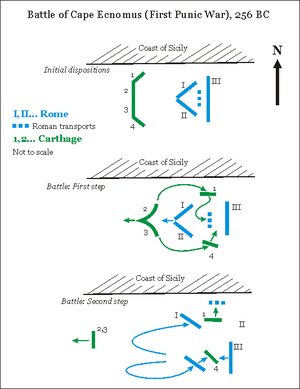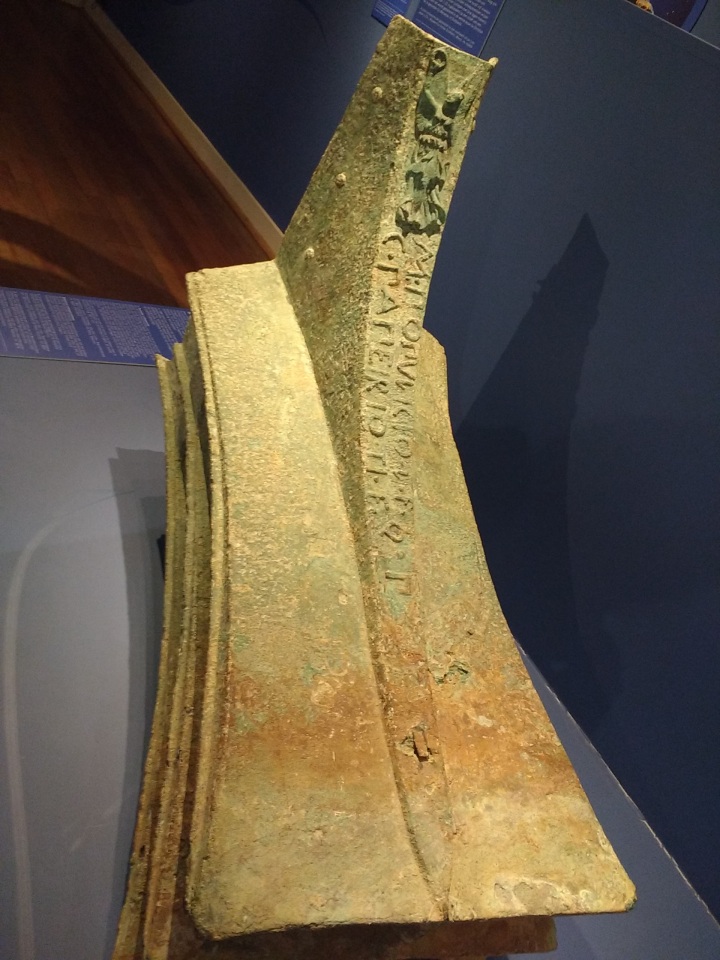The First Punic War was predominately a naval war. Sure there were land battles on Sicily and a couple of them on the North African shore, but most of the battles were fought on sea. Why? Because Carthage realised their mercenary army was useless against the Roman legions (nop, these were not the Marian and Imperial legions that served professionally. Nor were they the men who would end up being in a perpetual state of war during the 2nd Punic War.).
Carthage had decided to cut off the roman supplies using its superior navy. For a civilization that thrived on maritime trade, that was a no brainer. Rome, had to now fight someone who had an advantage on a theatre of war they had not ventured in.
Hellenistic Warships.
First, the warships that were in use in the Hellenistic era. The common warships of the time were the triremes and quinquereme. They were called ‘threes’ and ‘fives’ respectively. Those numbers represented the number of rows of oars per side. So obvious to say, the Quinqueremes were heavier counterparts of the triremes. All the ships had an encased hull around their rowers. This was to protect them from arrows. It did nothing to save them from a ramming attack. According to Polybius, these quinqueremes which were the principal ships of both fleets were around 45m long and had crews of 400-420 men (rowers, sailors and marines). They weighed in at around a 100 tons.
The naval tactics at the time was to manoeuvre the ship into the side of the other ship and in a short burst of speed, ram into them. The prow of each ship had a bronze ram. This metal ram could smash into the wooden sides of the ship, creating a fatal breach which would disable and sink the enemy vessel. The panic from the lower decks where the rowers were, would not be a pleasant site. The downside of the tactic? Proper manoeuvring. Only hitting the sides were effective and in large naval battles, a captain may not have that much space. An effective captain, would have to be careful how he rows through the battle, especially if no wind is prevailing. To ram, the crew would have to row at a very high intensity for a short burst, which would be tiring. A burnt out rowing crew would mean the ship is dead in the water.
Years of naval power meant Carthage had a strong navy before Rome even considered building one. Yet for some unknown reason, they NEVER contested the Roman landing of Sicily at the start of the war. Like, really why would you let your opponent take an advantage. This move would prove fatal for the war, as the conquest of Syracuse allowed Rome to have the locals supply their army. No Navy? No Problem.
How did Rome get its navy?
Our lovely Polybius, the best historian for this era, said the Romans had studied a storm-wrecked quinquereme to get an understanding of the ship. Others suggest Rome had a small navy, to patrol the Italian coast against pirates. The Romans realised, unhappy allies of Carthage on Sicily and the powerful Carthage navy will return. It was time for Rome to expand its naval arm.
The Roman Senate using the captured/ship-wrecked or existing costal ships and financed a new fleet. This was to be around 120 vessels strong, with 100 quinqueremes. Rome had financial power to match them in terms of ships and men, but they would not have any experienced sailors. They tasted defeat in the first few encounters. The Battle of the Lipari Islands saw all 17 Roman ships and the consul, Gnaeus Cornelius Scipio who was the first to command a Roman Fleet was humiliated. He was handed the cognomen ‘Asina’. In Latin it’s the feminine version of donkey. (It would not harm his career and Scipios loved fighting Carthage. Besides it makes it easier to identify him, just like we can easily identify Scipio Africanus).

The Romans realised, they have a superior land army but are unable to match the conventional naval tactics and the veteran crews of Carthage. Solution: Corvus. The Corvus is a marvellous piece of military engineering and changed the tide of the conflict. Developed from a Syracuse device, this bridge was 11m long and 1.2m wide. It was mounted on an axis and could rotate around a 180 degree arc. With pulleys it would be raised and lowered. It was at the prow of the ship and had a hook on the end, so that it stayed firmly on the ship. With the arc, a roman ship did not need as much manoeuvring, and could easily latch onto another vessel. Every Roman Vessel had around 60-80 marines. Armed nearly as well as the legions (but had a smaller, circular shield), the Marines could board an enemy vessel and capture it with relative ease. Problem Solved.

Rome at Sea
Battle of Mylae (260 BCE), at a cost of 11 ships, the Romans sink 13 ships and capture 30. To Carthage, this would no doubt be shocking. Losing on your own back yard! The biggest Roman naval victory cape at the Battle of Cape Ecnomus (256BCE). 330 Roman and 350 Carthaginian vessels fought. 24 Roman vessels were lost, but they sunk 30 and captured 65. This was after the Carthaginians tried to lure the Roman battle squadrons away and attacked the transports. The only defence was a smaller third battle squadron. They held off till the main roman squadrons, commanded by the consuls would return.

The Romans had to battle, not only the Carthaginians but the weather. After picking up the survivors of Regulusus’s and defeating Carthage in yet another naval encounter, a storm of Southern Sicily destroyed the fleet. Less than 1/3rd of the 264 vessel fleet survived and over 100,000 men were lost. Carthage took advantage but the Romans, showing a resiliency that would persist raised a new fleet. Unfortunately, once again this fleet would be destroyed by storms with all hands lost. Rome for now would not fight on the sea.
Rome would rebuild a fleet around 250BCE but would be defeated at the Battle of Drepana. That battle saw 90 roman ships lost. Another fleet (smaller) was lost to storms. The men survived and moved onto the land. With heavy manpower losses and financial stress, Carthage took the initiative. With Siciliy in doubt, Rome rebuilt a new fleet of 200 vessels, donated in part by the wealthy citizens. With a resounding victory at the Battle of the Aegates, Rome won the war.

The Naval theatre was costly. Rome lost over 600-700 ships. Three times it lost entire fleets to storms (probably more ships were lost to nature than Carthage. So much for them being a naval power). But what was seen, was the determination to win the war at any cost. The Romans ingenuity also served them well, when they started to use the Corvus. While its use died after Cape Ecnomus (no mention in records), it was safe to assume that years of fighting on sea meant Rome understood the basics of naval warfare. They could better train the crews. This meant they could hold their ground later on.

The sea was the major backdrop for the First Punic war. However, the land battles had their role to play in the outcome of the war. This will be covered in the next post, where the land theatre of the war is discussed. It pits the Polybian (Maniple) legions of Rome against the Carthaginian Mercenary army.


